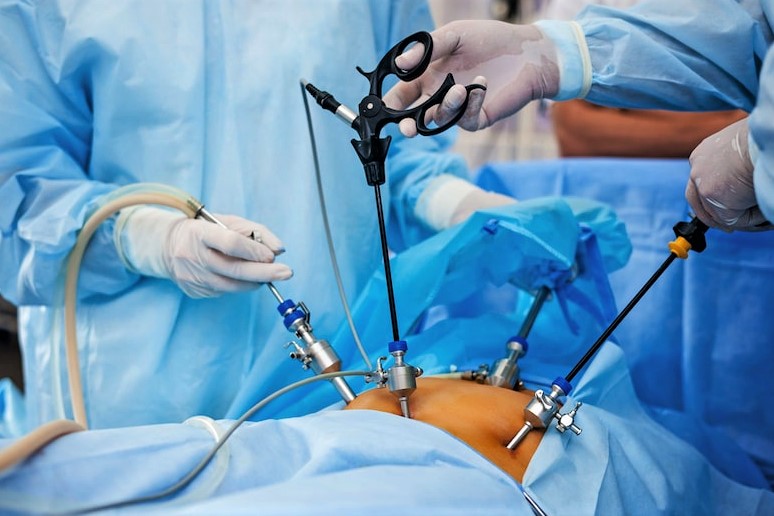
Gynaecological laparoscopy: what is it and when should it be performed?
Laparoscopy is a technique that allows you to ‘see’ inside the abdomen, through an instrument called a laparoscope
This is a thin, rigid tube equipped with optical fibres, through which light travels, which is introduced into the abdomen through a small incision near the navel.
Other parts connected to the laparoscope make it possible to perform ‘sky surgery’.
When laparoscopy is indicated
Laparoscopy is recommended as a diagnostic procedure to determine whether the pelvic pain reported by the woman is a result of: endometriosis, pelvic inflammatory disease, extrauterine pregnancy.
It also makes it possible to define whether a pelvic tumescence is a liquid or solid cyst connected to the ovary, or a fibroid or myoma in the uterus.
Laparoscopy also makes it possible to detect an infertility problem, e.g. the presence of adhesions or malformations of the internal genital apparatus
In addition, the chromatographic test is used to check whether the tubes are open or closed.
This test consists of injecting dye (methylene blue) through the uterus and then observing through the laparoscope the passage of the dye through the tubes and its escape into the abdominal cavity.
It is envisaged as a surgical technique in many pathologies: endometriosis, even in the presence of cysts of various sizes; extrauterine pregnancy, allowing the affected tuba to be preserved with a good restoration of its functionality; ovarian cysts, even of considerable size, in fact, they are first aspirated, then dissected and then removed; uterine fibroids, especially if subserous and pedunculated; pelvic adhesions, with good results in completely freeing the pelvis; urinary incontinence, which can be corrected with various laparoscopic techniques.
Tubal sterilisation is an operation that can be performed laparoscopically through the application of clips.
Laparoscopy requires special preparation: fasting from midnight the day before surgery; bowel cleansing enema; partial trichotomy.
On the day of surgery antibiotic prophylaxis is performed and the patient is asked to empty her bladder.
Anaesthesia is always necessary to allow for better relaxation of the patient.
Therefore the following investigations must have been performed: blood tests, electrocardiogram and chest X-ray.
What happens during laparoscopy
The procedure begins with the introduction of a special instrument called a hysteroinjector into the uterus in order to mobilise it.
Then a small incision is made at the level of the umbilicus, through which gas is introduced into the abdomen with the special Verres needle.
This gas separates the pelvic organs from each other and from the abdominal wall, allowing adequate vision.
Then through the umbilical incision the laparoscope is introduced.
Eventually through small incisions in the lower and lateral wall of the abdomen the instruments necessary to perform surgical acts are introduced.
At the end the laparoscope is removed; the gas leaves the abdomen and the hysteroinjector is removed.
A few stitches are applied to the abdominal incisions and a small bandage is placed to protect the wounds.
Diagnostic laparoscopy takes 15-20 minutes, while operative laparoscopy can take up to an hour or more, depending on the complexity of the procedure.
What happens after the test
After the laparoscopy, the patient may complain of some slight discomfort, which, however, disappears within a few days.
Pain may be felt in the shoulders, back or abdomen: a sensation due to the gas used to distend the abdominal cavity.
Nausea may appear, usually a consequence of the gas used, the manipulation of the intestinal loops, as well as the anaesthesia.
Swallowing discomfort may occur due to tracheal intubation performed to facilitate breathing.
In some cases there is difficulty concentrating in the hours following the operation due to the anaesthesia (activities requiring particular concentration, such as driving a car, should be avoided for 48 hours).
A small amount of bleeding from the vagina may persist for a few days.
The healing of wounds on the abdomen usually takes 5-6 days.
Post-operative hospitalisation is limited to 1-2 days.
The evening after the operation is free.
In a few cases, a longer hospital stay is necessary.
Home convalescence is also short; sexual relations can be resumed 2-3 days after the operation.
Treatment following laparoscopy varies from patient to patient.
Read Also
Emergency Live Even More…Live: Download The New Free App Of Your Newspaper For IOS And Android
Laparocele: What It Is And How To Treat It
Kidney Cancer: Laparoscopic Surgery And The Latest Technologies
Fusion Prostate Biopsy: How The Examination Is Performed
CT (Computed Axial Tomography): What It Is Used For
What Is An ECG And When To Do An Electrocardiogram
MRI, Magnetic Resonance Imaging Of The Heart: What Is It And Why Is It Important?
Mammary MRI: What It Is And When It Is Done
What Is Needle Aspiration (Or Needle Biopsy Or Biopsy)?
Positron Emission Tomography (PET): What It Is, How It Works And What It Is Used For
CT, MRI And PET Scans: What Are They For?
MRI, Magnetic Resonance Imaging Of The Heart: What Is It And Why Is It Important?
Urethrocistoscopy: What It Is And How Transurethral Cystoscopy Is Performed
What Is Echocolordoppler Of The Supra-Aortic Trunks (Carotids)?
Surgery: Neuronavigation And Monitoring Of Brain Function
Robotic Surgery: Benefits And Risks
Refractive Surgery: What Is It For, How Is It Performed And What To Do?
Single Photon Emission Computed Tomography (SPECT): What It Is And When To Perform It


